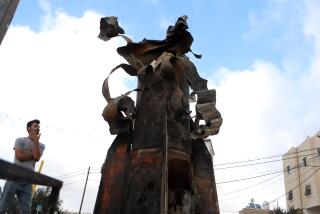âHitting a Bullet With a Bulletâ
Immediately after the Sept. 11 terrorist attacks, opponents of missile defense made a persuasive argument: The threat to the U.S. from terrorists using low-tech weapons was far greater than that of a rogue nation launching an intercontinental ballistic missile. And the subsequent outbreaks of anthrax made arguments for a $100-billion missile defense system look all the more foolish.
But with military operations in Afghanistan winding down earlier than expected, national security discussions have begun to shift back to missile defense, and Bradley Grahamâs timely âHit to Kill,â a review of the missile defense systemâs history, politics and science, is likely to help refuel and intensify the debate.
Graham warns us from the onset that the âthe story is complex and contentious. It is a tale of disputed intelligence assessments and reactive political decisions, of hurried technical development and embarrassing misfires, of dated old world treaties and ill-defined new world orders.â And indeed, Grahamâs book is one of the most exhaustive looks at missile defense, which itself defies simple description. In its purest form, missile defense is often described as âhitting a bullet with a bullet.â Under President Bushâs more ambitious plans, missile defense would involve creating a shield over the United States with a range of weapon systems based in the sea, on land and in the air.
A longtime military and foreign affairs reporter for the Washington Post, Graham interviewed more than 300 people and pored over reams of material public and classified to produce a book containing plenty of engaging insights and anecdotes. He reveals how Boeing Co. employees in Downey got hold of a competitorâs confidential document outlining a test plan for the so-called kill vehicle, an interceptor that destroys incoming missiles with its kinetic energy. The document had apparently been left at the office by the Army during a meeting with Boeing employees. Whether it was left there intentionally or not, Boeing engineers studied the document, an ethical violation that eventually got the company kicked out of the $400-million competition to build the kill vehicle.
Interviews with Bush and former President Bill Clinton also provide a rare glimpse into how the two men came to their respective positions on missile defense. For Clinton, who advocated a more limited single system, the debate over missile defense was not only about whether it was technically feasible but also whether it was politically acceptable. For Bush, it was more ideological. âI donât think Iâd really focused on missile defense until Ronald Reagan brought up âStar Wars,ââ he told Graham, adding how, in 1998, he watched a film of an Israeli antimissile system that â[t]o me, spoke about the [systemâs] potential.â
For missile defense neophytes, Grahamâs chapter âBack to the Futureâ is one of the more succinct and useful synopses of Americaâs preoccupation with building a shield from foreign missile attacks, beginning with post-World War II intelligence reports that showed how the Nazis had plans to build a two-stage rocket that could have crossed the Atlantic Ocean. And the story aptly starts with a look at the North American Aerospace Defense Command facility in Coloradoâs Cheyenne Mountains, where visitors get to watch on a radar screen a simulation of the U.S. coming under missile attack.
Graham writes how inevitably someone asks when the U.S. forces would knock down the deadly intruders. âSometimes the briefer waits an expectant moment before responding, sometimes not. But always the answer is the same: âThey wouldnât, because they canât.â And the visitors go away in disbelief.â It was the same experience, he says, that left a powerful impression on the future president, Ronald Reagan, and compelled Reagan to launch the âStar Warsâ initiative.
But the myriad details of Grahamâs chronicle can also be exhausting and numbing for many outside the Washington Beltway who may not much care about endless ebb and flow of debate among the congressional committees and subcommittees, presidential cabinets, Pentagon war rooms and think tanks. At times it seems as if Graham is trying too hard to be evenhanded and not offend those who agreed to be interviewed, which ultimately muddies any chance of figuring out how America came to spend $75 billion in the last two decades without much to show for it. There also is something oddly missing from the discussion; namely, the role of money politics, from parochial interests of states such as California and Alabama--home of major missile defense research and development centers--to lobbyists and defense contractors who stand to gain handsomely.
*
Peter Pae is a Times staff writer who covers aerospace.
More to Read
Sign up for Essential California
The most important California stories and recommendations in your inbox every morning.
You may occasionally receive promotional content from the Los Angeles Times.










